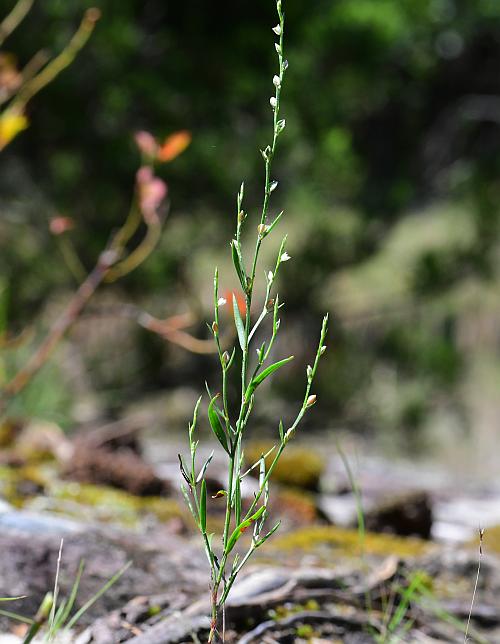Polygonum tenue Michx.
Slender Knotweed

Native
CC = 6
CW = 5
MOC = 60
© SRTurner
Polygonum tenue Michx.Slender Knotweed | |
 |
Native CC = 6 CW = 5 MOC = 60 |
© SRTurner |
|
Family - Polygonaceae Habit - Annual forb with a woody taproot.
Stem - Strongly ascending to erect, to 45 cm, branched, glabrous. Ocreae inconspicuious.
Leaves - Alternate, simple, sessile. Blades 5-40 mm long, mostly 4-12 times as long as wide, linear to narrowly lanceolate, green to pale green or light green (turning orange in autumn), with 2 longitudinal folds or grooves parallel to the midvein, the margins with minute, spinescent teeth.
Inflorescence - Axillary, the flowers solitary or in small clusters, sometimes appearing as terminal spikelike racemes.
Flowers - Tepals 5 in 2 whorls, fused near the base, 2.5-4.2 mm long, green with white, pinkish-tinged, or brown margins, much longer than the fused portion, often somewhat incurved above the fruit, the outer 3 lobes longer than the 2 inner lobes and more or less enclosing them, boat-shaped to hooded at the tips, the inner 2 lobes shorter and flat. Stamens usually 8, included, the bases dilated. Styles 3, the stigmas capitate.
Fruits - Achenes, enclosed or somewhat exserted, the surface finely pebbled or with lines of minute papillae, dark brown to black, not shiny. Flowering - July - October. Habitat - Glades, savannas, dry upland forests openings, sand prairies, streambanks, railroads, open disturbed areas; usually on acidic substrates. Origin - Native to the U.S. Lookalikes - Other members of the genus, such as P. aviculare and P. ramosissimum. Other info. - This is one of the more inconspicuous plants around. Its growth habit is sparse and wispy and the flower small, widely spaced in the inflorescence, and typically only opening one or a few at a time. It is an easily recognized species due to the pleated appearance of the leaf underside. Close examination of the leaf margins will also reveal numerous tiny teeth. The ocreae are not easily recognized as such. The plant is less common than some others in the genus, though it occurs throughout most of the southern 2/3 of Missouri. Its wider range is unusual, with multiple populations scattered and disjunct across much of the eastern U.S. The plant favors dry areas with acidic substrate. Sandstone glades and upland prairies are good habitats in which to find it. Photographs taken at Don Robinson State Park, Jefferson County, MO, 9-10-2021 (SRTurner). |